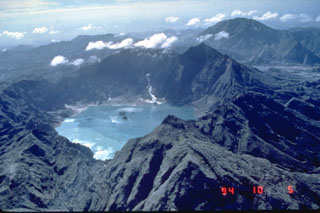Report on Pinatubo (Philippines) — 24 November-30 November 2021
Smithsonian Institution / US Geological Survey
Weekly Volcanic Activity Report, 24 November-30 November 2021
Managing Editor: Sally Sennert.
Please cite this report as:
Global Volcanism Program, 2021. Report on Pinatubo (Philippines) (Sennert, S, ed.). Weekly Volcanic Activity Report, 24 November-30 November 2021. Smithsonian Institution and US Geological Survey.
Pinatubo
Philippines
15.13°N, 120.35°E; summit elev. 1486 m
All times are local (unless otherwise noted)
PHIVOLCS reported that a weak phreatic explosion at Pinatubo was recorded during 1209-1213 on 30 November. The event was likely drive by shallow hydrothermal processes based on very low seismicity recorded during the previous few days, low diffuse carbon dioxide flux from the lake, and a notable infrasound signal. A plume mostly comprised of steam was seen rising above weather clouds within a few minutes of the end of the event. The Tokyo VAAC stated that the plume rose to 13.4 km (44,000 ft) a.s.l. and drifted W based on satellite data.
Geological Summary. Prior to 1991 Pinatubo volcano was a relatively unknown, heavily forested lava dome complex located 100 km NW of Manila with no records of historical eruptions. The 1991 eruption, one of the world's largest of the 20th century, ejected massive amounts of tephra and produced voluminous pyroclastic flows, forming a small, 2.5-km-wide summit caldera whose floor is now covered by a lake. Caldera formation lowered the height of the summit by more than 300 m. Although the eruption caused hundreds of fatalities and major damage with severe social and economic impact, successful monitoring efforts greatly reduced the number of fatalities. Widespread lahars that redistributed products of the 1991 eruption have continued to cause severe disruption. Previous major eruptive periods, interrupted by lengthy quiescent periods, have produced pyroclastic flows and lahars that were even more extensive than in 1991.
Sources: Philippine Institute of Volcanology and Seismology (PHIVOLCS), Tokyo Volcanic Ash Advisory Center (VAAC)

